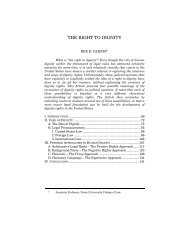A Right to Media? Lorie M. Graham - Columbia Law School
A Right to Media? Lorie M. Graham - Columbia Law School
A Right to Media? Lorie M. Graham - Columbia Law School
You also want an ePaper? Increase the reach of your titles
YUMPU automatically turns print PDFs into web optimized ePapers that Google loves.
448 COLUMBIA HUMAN RIGHTS LAW REVIEW [41:429<br />
being and physical and mental health.” 68 In order <strong>to</strong> achieve these<br />
ends, the state shall:<br />
(a) Encourage the mass media <strong>to</strong> disseminate information<br />
and material of social and cultural benefit <strong>to</strong> the<br />
child . . . (b) Encourage international co-operation in the<br />
production, exchange and dissemination of such<br />
information and material from a diversity of cultural,<br />
national and international sources; (c) Encourage the<br />
production and dissemination of children’s books; and (d)<br />
Encourage the mass media <strong>to</strong> have particular regard <strong>to</strong> the<br />
linguistic needs of the child who belongs <strong>to</strong> a minority<br />
group or who is indigenous. 69<br />
Similar <strong>to</strong> the Children’s Convention, the International<br />
Labour Organization Convention No. 169 speaks <strong>to</strong> the use of “mass<br />
communications” <strong>to</strong> ensure that indigenous peoples are made aware<br />
of their rights under the Convention. 70 The U.N. Commission on the<br />
Status of Women has also addressed media issues as they relate <strong>to</strong><br />
women’s full enjoyment of freedom of expression, equal access <strong>to</strong><br />
media, balanced and diverse portrayals by the media of women and<br />
their multiple roles, and media information aimed at eliminating all<br />
forms of violence against women. 71 The Commission noted in<br />
particular the importance of media education in raising awareness<br />
concerning stereotyping and equality issues. 72<br />
In addition <strong>to</strong> U.N. human rights instruments and treaty<br />
bodies, a number of other U.N. bodies have explored the linkages<br />
between media and freedom of expression and information.<br />
For instance, in recognition of media’s many benefits, UNICEF has<br />
created an entire program dedicated <strong>to</strong> the creation of youth-oriented<br />
media. The Voices of Youth website utilizes new forms of media <strong>to</strong><br />
foster media awareness and participation by young people<br />
everywhere. 73 The voices of children from rural and indigenous<br />
68. Id.<br />
69. Id.<br />
70. Indigenous Convention, supra note 39, art. 30 (calling for governments<br />
<strong>to</strong> adopt measures appropriate <strong>to</strong> the traditions and cultures of the peoples<br />
concerned and if necessary, <strong>to</strong> use written translations and mass communications<br />
in the languages of these people <strong>to</strong> do so).<br />
71. ECOSOC, Comm’n on the Status of Women, Report of the Forty-Fifth<br />
Session, p. 12–13, 18, 20, U.N. Doc. E/2001/27, E/CN.6/2001/14 (2001).<br />
72. Id. at 20.<br />
73. UNICEF, Voices of Youth, http://www.unicef.org/voy/index.php (last<br />
visited Feb. 5, 2010).















